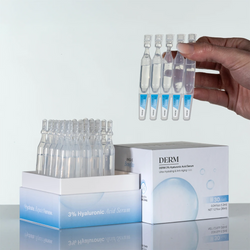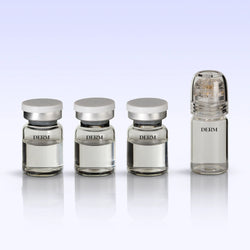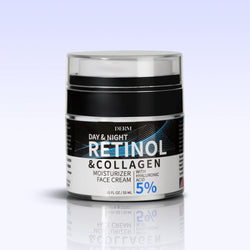Dealing with Dark Circles After 45: What Really Works

Written by Our Editorial Team
6 MINUTES READ
Look in the mirror after a good night's sleep, and they're still there, those persistent dark circles that somehow seem to have taken up permanent residence under your eyes.
If you're over 45, you've likely noticed that these shadows have become more pronounced, regardless of how well-rested or hydrated you are.
Dark circles after 45 aren't just about lack of sleep or genetics anymore. As we mature, multiple factors converge to create this challenging cosmetic concern.
The good news?
Understanding the real causes means you can finally find solutions that actually work.

Why Dark Circles Get Worse After 45
Dark under-eye circles have different causes at different life stages. After 45, several age-related changes contribute to their appearance:
Thinning Skin
The skin around our eyes is already the thinnest on our body, about 0.5mm compared to 2mm elsewhere.
After 45, collagen and elastin production naturally decline, making this delicate skin even thinner.
The result? Blood vessels beneath the surface become more visible, creating that bluish-purple appearance.
Volume Loss
As we age, we lose fat in our face, including the supportive fat pads under our eyes. This creates a hollow that casts a shadow, contributing to the appearance of dark circles.
This volume loss accelerates during and after menopause when estrogen levels drop.
Increased Pigmentation
Years of sun exposure, environmental damage, and hormonal changes can trigger increased melanin production under the eyes.
This hyperpigmentation creates brownish dark circles that differ from the bluish ones caused by visible blood vessels.
Bone Resorption
A less discussed but significant factor: after 45, the bones that support our eye area begin to recede slightly.
This structural change creates deeper tear troughs and more pronounced shadows.
Lifestyle Factors That Amplify the Problem
While these age-related changes happen naturally, certain factors can make dark circles more noticeable:
- Screen time: The increased time we spend on digital devices causes eye strain and can worsen the appearance of dark circles.
- Sleep position: Side or stomach sleeping can cause fluid to pool under your eyes, emphasizing shadows.
- Allergies: Seasonal allergies trigger inflammation and increased blood flow around the eyes.
- Dehydration: Less moisture in the skin makes thinning more apparent.
Moving Beyond Concealer: What Actually Works?
For years, the standard advice for dark circles has been cucumber slices, cold tea bags, and plenty of concealer. But for mature skin, these superficial approaches fall short. Here's what really makes a difference:
1. Target the Right Type of Dark Circle
Before treating dark circles, identify which type you have:
- Vascular (blue/purple): Caused by visible blood vessels beneath thin skin
- Pigmented (brown): Caused by melanin deposits
- Structural (shadowed): Caused by hollows and tear troughs
Each type responds to different treatments. Using the wrong approach not only wastes time and money but can sometimes worsen the problem.
2. Strengthen Delicate Skin with Peptides
For vascular dark circles (the bluish kind), strengthening the skin to make blood vessels less visible is key. Peptides, short chains of amino acids that serve as building blocks for proteins like collagen and elastin, can significantly improve skin thickness when applied consistently.
Peptides work by signaling your skin cells to produce more collagen, essentially teaching aging skin to behave like younger skin.
For best results, look for formulations containing multiple peptide types that target different aspects of skin strengthening.
3. Address Volume Loss with Targeted Technology
The shadowy appearance caused by volume loss responds well to technologies that stimulate the skin's natural regenerative processes.
Treatments that deliver micro-currents or advanced stimulation can help rebuild the supportive structures under the eye.
For example, advanced eye treatment technologies penetrate to deeper skin layers where they stimulate cellular energy production.
This increased cellular activity helps rebuild the supporting matrix beneath the eye, gradually reducing the hollow that creates shadows.
4. Tackle Pigmentation with Vitamin C and Niacinamide
For the brownish dark circles caused by pigmentation, ingredients that inhibit melanin production while gently exfoliating can make a significant difference.
Vitamin C is particularly effective because it brightens skin while also strengthening collagen, addressing both pigmentation and skin thinning simultaneously.
Niacinamide (vitamin B3) complements these effects by reducing inflammation and supporting the skin barrier.
5. Reconsider Your Eye Cream Approach
Many eye creams promising to eliminate dark circles contain ingredients that are either not concentrated enough to make a difference or are too irritating for delicate under-eye skin.
For mature skin, look beyond marketing claims to specific active ingredients:
For vascular circles: Peptides, caffeine, hesperidin methyl chalconeFor pigmented circles: Vitamin C, niacinamide, kojic acid- For structural circles: Hyaluronic acid (especially multi-weight versions), peptides
Most importantly, consistency matters more than price point.
The most expensive eye cream applied occasionally won't match the results of a well-formulated product used faithfully twice daily.
6. Consider Advanced At-Home Devices
One of the most exciting developments for treating dark circles after 45 is the emergence of effective at-home devices that deliver professional-level technologies.
Advanced eye treatment devices can address multiple causes of dark circles simultaneously:
- Advanced technology increases cellular energy and collagen production
- Gentle micro-currents stimulate facial muscles and improve circulation
- Together, they help rebuild the supporting structure under the eyes
The key advantage of these devices is that they work beneath the skin's surface, where dark circles actually originate.
Unlike topical products that can only reach the outermost layers, these technologies address the deeper structural issues.
Creating Your Dark Circle Strategy After 45
The most effective approach combines multiple strategies:
Creating Your Dark Circle Strategy After 45
The most effective approach combines multiple strategies:
Morning Routine:
- Gentle cleansing without tugging the delicate eye area
- Peptide-rich eye treatment to strengthen skin
- Vitamin C serum if pigmentation is present
- Moisturizing eye cream with hyaluronic acid
- Sunscreen (crucial for preventing further pigmentation)
Evening Routine:
- Thorough but gentle makeup removal
- Treatment with Multi-Peptide Massaging Eye Cream, which uses advanced technology to stimulate skin renewal
- Hydrating eye treatment with peptides and rebuilding ingredients
Weekly:
- Gentle exfoliation to remove dead skin cells that can emphasize shadows
- Extra hydration with a specialized eye mask or concentrated treatment
Results You Can Realistically Expect
Unlike many beauty concerns that promise overnight results, addressing dark circles after 45 requires patience and consistency.
Realistic expectations include:
- Within 2-4 weeks: Improved hydration and slight brightening
- Within 4-8 weeks: Noticeable reduction in pigmentation (if present) and some improvement in skin thickness
- Within 8-12 weeks: Structural improvements begin to show, with less pronounced hollows and shadows
The most successful approach combines daily care with targeted technology like the Multi-Peptide Massaging Eye Cream, which addresses the underlying causes of dark circles rather than just masking them.
When used consistently, these technologies stimulate your skin's natural processes to rebuild and strengthen the delicate under-eye area.
Beyond Products: Lifestyle Adjustments That Support Your Efforts
While the right products and technologies make a significant difference, certain lifestyle adjustments can enhance your results:
- Adjust sleep position: Try sleeping on your back to prevent fluid accumulation
- Manage allergies: Treat seasonal allergies promptly to reduce inflammation
- Consider supplements: Vitamin K, hesperidin, and collagen supplements may help strengthen capillaries and support skin structure from within
- Stay hydrated: Proper hydration helps maintain skin thickness
- Protect your eyes: Reduce digital eye strain with regular breaks from screens
The Bottom Line on Dark Circles After 45
Dark circles after 45 aren't simply a sign of fatigue, they're a complex cosmetic concern resulting from multiple age-related changes.
Addressing them effectively requires moving beyond concealer and cucumber slices to solutions that target the underlying structural changes.
By combining targeted ingredients, advanced technologies like the Derm™ Multi-Peptide Massaging Eye Cream, and consistent care, you can significantly improve even stubborn dark circles that have resisted previous treatments.
The key is understanding that effective treatment means addressing the cause, not just covering the symptom.
What approaches have you tried for dark circles? Share your experience!





